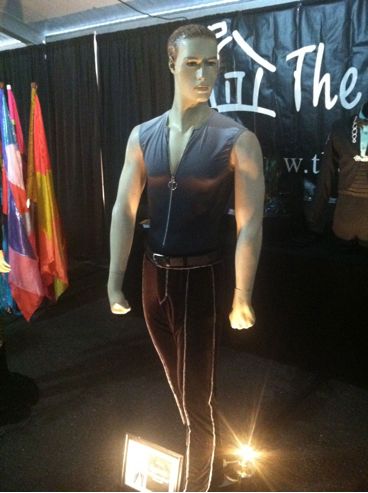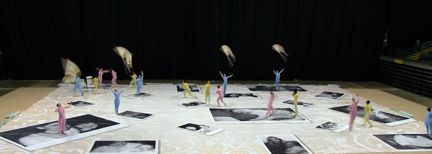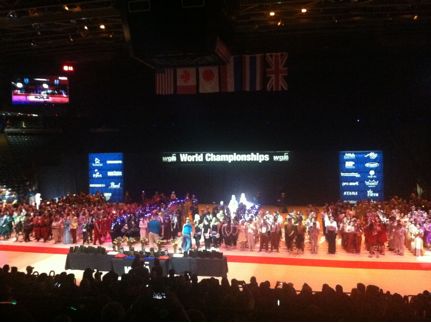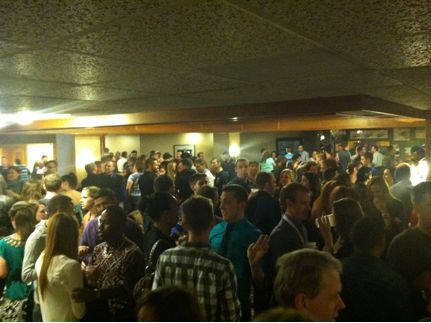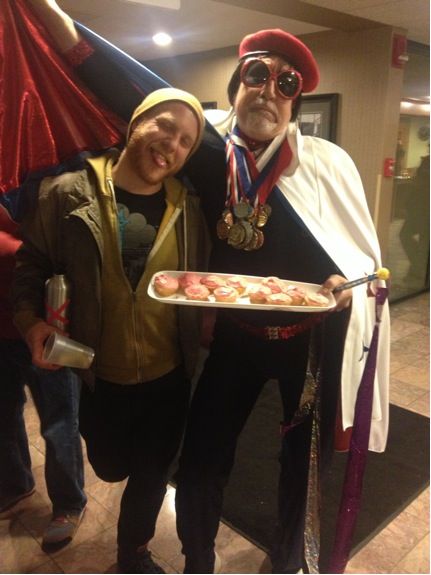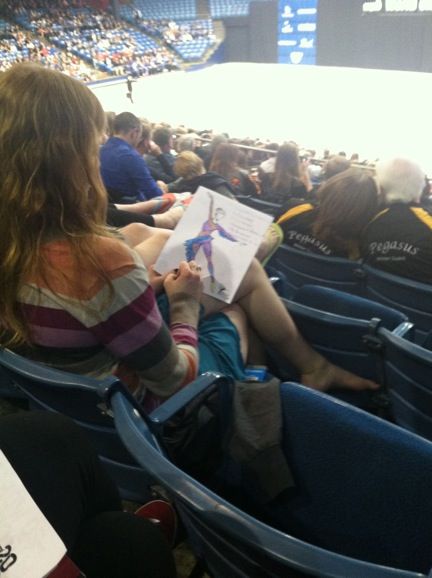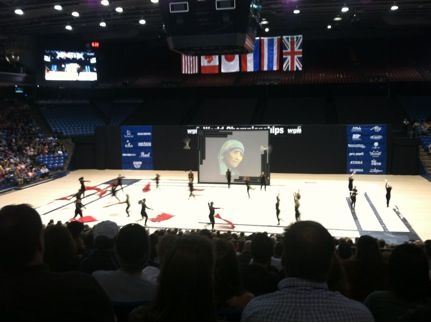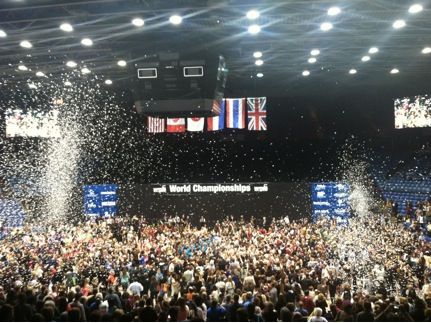GET IT!
| April 8, 2014
LeeAnn Rossi from Todomundo went to the color guard world championships in Dayton, Ohio in April 2013 as part of the research for a project we’re all doing in summer 2015. More about that sometime in the future.
What, you may ask, is color guard? Well, it’s connected with drum line and marching band—but it’s really a thing unto itself. It involves routines that last about 5 minutes and involve wooden rifles, sabers and flags. It’s a vernacular performance artform that is huge in most of North America, but this “sport of the arts” as it is called, is virtually unknown amongst us city folks.
LeeAnn and the others who joined her had a wonderful time. She talked about how emotionally moving and incredible it was for weeks after. This is her diary. -DB
Friday April 12
Woke up at 5am to be shuttled to the airport by 6—woof! Met Chris pre-security and had a great time getting to know him while our flight was delayed for HOURS. [Chris Giarmo is a performer I met through choreographer Annie-B Parson when they both assisted on DB's Everything That Happens tour. Chris was in color guard when he was in high school, growing up in NJ.] Chris tells me that people will be using the word “twerk” a lot and I’m intrigued (mostly because where I come from that term is used in a kinda freaky sexual way, not something you’d shout out at a sports competition). We finally boarded the flight at 11:30am and landed in Dayton by 1:30pm—which meant we’d already missed half the day of the world semi-finals.
We dropped our stuff at the hotel and walked over the river to the Dayton Arena. While in the airport, Chris had the genius idea to start looking up WGI hashtags on Vine and found one of this girl saying “date-in-reen-a”—what the hell was she saying?!?! As soon as we walked up and saw the “University of Dayton Arena” sign in red, we knew what she was getting at.
We walked up to the ticket counter and asked for tickets for all performances through the finals. I was told that the finals were sold out. Sold out! Are you kidding me?! The whole reason for going—the world championships—are sold out. The girl at the ticket counter mentions that they’re planning on releasing about 30 tickets tomorrow at 4PM. She doesn’t know anything more and isn’t able to put our names down on a list, but she’s really sweet about the whole thing. I buy wristbands for the semis we’re about to walk into and tickets for the evening A class finals and tomorrow morning’s open class finals. This adds up to almost $300 and I can’t believe it. People are spending a lot of money on this activity!! Do parents get cheaper tix? Teams? How many people are solely spectators that pay full price for their love of the sport of the arts?
Chris and I walk in, our bags are checked for outside food, the show is being filmed and shown on giant screens throughout the hallways and I’m getting excited. We grab a program for $8 and sit in the seats in the 200 level stage left. I realized we just missed two teams from NJ (Black Watch and Emanon) and I’m a little upset about the flight delay because one of my main goals is to determine whether or not there are enough good teams in the tri-state area to invite to our proposed project in NYC.
In the stands around us are several kinds of groups: parent groups (made obvious by wearing shirts with team names embroidered on them or buttons with pictures of their children), performer/competitors (made obvious by their spandex workout attire and dirty hair up in tight buns) and instructors (men sitting in packs of 4-6 who may or may not instruct competing teams or be from the same city or state—it’s unclear). The common thread between all these groups is that they KNOW when to cheer. They just know. Whereas I’m a little lost—the angle we’re viewing the action from doesn’t afford a head-on view, so I find myself attaching my gaze to the girl who tumbles over there by herself and end up missing some amazing action I didn’t know I was supposed to be looking for, which I’m alerted to by the shrill screams of applause. People are screaming “WERK!”and “GET IT!” (No “twerk”s yet, unfortunately.)
After a break and hyped up on soda, we decide to head up to the third tier of seating in the middle to try and mimic the view from the overhead camera that is projected on screens during the performances. It’s a much better view than where we were previously, but the camera angle is still the absolute best. It allows you to see the entire production—the floor mat, flags being tossed, the patterns of the staging, etc.—in an entirely complete way. This view seems to be what the people who dream up the routines intend; it just seems crazy that if you’re there in person you aren’t seeing it from the best vantage point unless you’re watching the screen! Seated in front of us is a group of instructors. I think they’re from Louisiana because one of the guys has a jacket embroidered with Crescent City. They talk about all the teams in detail—costumes, dance moves, flags, tosses and catches. They say “WERK” a lot. It makes me want to say it, but I realize that that word coming out of my mouth would just sound silly. Absurdly silly. I realize that these instructors are likely from lesser class teams—A or Open—watching the teams that their kids aspire to be on. A woman behind me asks if I know where the Nutter Center is and I remember it on a map as one of the venues for the preliminary competitions. I’m beginning to realize how big this whole thing is. They take over four venues across Dayton and into Cincinnati—whoa!
The last half of the afternoon is spent watching world-class independent teams compete for a spot in the finals. These are the best of the best teams. They are awesome. It doesn’t strike me until afterwards that these teams have been performing the same routines in regional, state, national and now world competitions all year—the same exact routines performed hundreds of times, I’m sure. Chris and I keep comparing a lot of their dance moves and performative actions to gymnastics. This is their Olympics. I know that’s a little hype-y, but it’s true and you can sense that energy in the stadium.
The second to last team to go is Onyx. I am overwhelmed by their routine. It is very simple and supremely impressive. After a run of overly-themed routines with too many props, it is really nice to see a group of athletes/performers pare down and sweep everyone up solely with their talent. I have one note from that performance “OMG” and later I admit to Chris that I teared up; he did too.
Faced with a two-hour dinner break, we headed to the swag tent. There are vendors set up—people selling wooden rifles and sabers, T shirts, videos, costumes, shoes, gloves, bags, jewelry—very trade-show-like. I buy DVDs and a sweatshirt. Chris buys a florescent green shirt with “GET IT” screenprinted on the front.
At the DVD counter, the guy selling them to me mentions that his daughter was on a team last year and is taking a year off. During the finals she dislocated her knee, popped it back in and kept going. Wow! I can’t believe this. Chris and I take this time to get some of our questions answered. We learn that you can be practically any age on an independent team. His daughter is a senior in college. We walk back to the hotel with our goods, grab a drink and scarf down a quick non-concession stand dinner and then head back to the arena. The walk to and from our hotel to the arena isn’t long at all by NY standards, but there is NO ONE else walking.
We walked into the arena for the A class finals a little late and missed the first performance. They block off the walkways with rope during performances so that no one can obstruct the view of the judges, the cameras or the viewers; I’m sure it also helps the performers to not have people running around while they’re throwing rifles and sabers up in air, too. We have pretty good seats and I start to notice how big of a production this all is: there are guys walking around in weird hats hocking raffle tickets, women selling programs, and ads playing on the big screens between performances. There are beautiful box seats up above us all. The announcer is up there. In one box everyone is wearing a blue shirt; maybe they work for WGI [Winter Guard International—the color guard governing body]. Do they get to drink beer up there?
My notes on the teams from the first half (scholastic teams) are as follows: sweet, scary, green & yellow, bad costumes, bring them home, miss manners, cinderella, rainbow light obelisk, RED, pink flags—good!, feed the birds and baby pics on mat. The mother sitting beside us tenses up once her daughter’s team comes on. She is wearing about a dozen buttons on her shirt and her pride is palpable. I get a little teary watching her watch her daughter. The folks in front of us are involved in the “baby pic mat” routine. Those images on the floor mat are, in fact, images of all the girls on the team as babies. They win 1st place!!!
I went into this thinking the scholastic teams might not be as good as the independent teams (probably tied up in the notion that public schools can’t afford good programs and private or independent teams have parents and booster clubs with more money and generally more invested in the activity instead of just doing it as a school elective), but the scholastic teams rock. I sense that they are more regimented than the independent ones, though their themes are overtly emotional and angsty. Everything here is tied up in angst—the tension in their dance moves, the look in the performer’s faces, their audible sobs, the lulls in music—it’s emotionally draining. Sometimes hilarious, too.
The first normal song of the competition I hear is a Regina Spektor song in the Independent A finals. Completely unedited—which is pretty atypical for this world. More often the “music” is a collage of various bits of music and voice overs that is overtly yanking on the heartstrings.
The show ends and a lot of people clear out. Chris and I head front and center. The awards ceremony for the final is amazing. They turn off all the lights. “WGI World Champtionships 2013” is projected onto the floor. They bring out some black speaker-looking things in the corners as well as tables arranged with awards and medals. The announcer reviews details about all teams—where they’re from, their team name, the people associated with the team—one by one until all 30 teams are on the floor. The teams walk down the stairs onto the floor looking like blinged-out ravers. Flashing rings, glow-in-the-dark necklaces, blingy crowns, neon feather boas—they come prepared for this event. The announcer says, “Here are your WGI 2013 A Class final competitors” and glittery streamers pop out of the black speaker-looking canons that had been positioned on the floors over the kids. This is magical.
Winners are announced (from 15th place all the way through 1st), the dub step begins and a dance party forms on the floor.
During the ceremony, the parents for Luminosa (who entered the finals in 2nd place) were in front of us and the parents for Stonewall Independent (who entered the finals in 1st place) were behind us. The announcer named Stonewall Independent as the silver medalist and the Luminosa parents jumped to their feet screaming. The Stonewall parents did not appreciate this move and I overhead them saying how rude it was for them to cheer because it was obvious they were cheering for their own kids winning first instead of Stonewall. For the most part, though, it is a really respectful crowd. The kids on the floor all cheer for one another, take pictures with each other, and mingle at the dance party afterward.
Chris and I start the journey back to the hotel completely exhausted from a day that started earlier than usual. I’m looking forward to sleep, but as we approach the Marriott, we couldn’t see anything but people—inside and out. The ground floor of the hotel has been turned into a club (Club W—pronounced “Club Dub” we learn). Several bars are set up throughout the ground floor, outside the actual bar/restaurant. I’m overwhelmed.
We navigate the crowd to the bar and don’t talk much—there is so much to see and the fact that everyone seemingly knows each other is intimidating. We head back out into the main lobby because there’s more air there.
All these people are involved in color guard in some way—how we’re unsure. We don’t yet know if these are performers (we look for makeup and hair that would give it away), instructors (we look for the guys we sat behind earlier that day), or what. They can’t all be super fans. Surely not everyone works for WGI—they’re local and probably at home snuggled in bed. We talk about how to strike up a conversation; what’s our story, what do we say we are we doing here? Chris goes to grab another round of drinks and I get up enough courage to insert myself in the conversation three men are having about one of them being Facebook friended by someone they don’t know, but they realize they now see their “friend” standing across the room.
These guys become our insight into the world—two self-proclaimed “observers” who are completely wrapped up in the world of color guard, but have no direct affiliation with teams. They introduce us to someone who consults for an A team (the team with the rainbow light obelisk) and has been involved in guard to some degree all his life. He knows that he pours all this time and energy into kids who will eventually get too good for his A team and move on to Open and World levels, but to him, that’s the point. It’s about molding those young kids and giving them the skills and tools they need to go on and do bigger and better things. He has a day job—as it seems most people involved in the world do. He doesn’t get paid for his time; it’s all in the service of these kids—who are in some ways misfits. He remembers as a child being taken into this community and immediately accepted no matter what the outside world considered his flaws, and his involvement in color guard now is a way of giving something back.
This is a very insular world. These guys know everyone in the room: “That is a judge. That used to be the designer for X team. This is Sebastian—Sebastian is a superfan”. Here is a picture of Chris and Sebastian.
During this anthropological expedition to deepest Ohio we learned a lot about the makeup of teams. There is a director (who handles the business/operations) who is accountable to a board of advisors, and then there’s the designer (who is the creative director) and under that person there are choreographers, composers, costume designers and consultants that help tighten up the show. That’s a lot of people!
Not everyone likes every presentation (there is some criticism of music or costumes or themes—but not much, really). This world that seems too ironic for words to an outsider is really a group of people genuinely in it for moving and altruistic reasons. The different classes have nothing to do with age, but rather with skill level (i.e.—being able to toss their rifle and get three spins on an A team, as opposed to seven on a World team).
I head to bed about 3AM, ready for another day of guard action!
Saturday April 13
Shit! I overslept! I was supposed to meet Chris at 8:30 and I wake up knowing something’s wrong at 8:45. Quickly brush teeth, dress and downstairs by 9. We don’t miss too much of the Independent finals. It’s interesting to see the subtle differences between A and Open teams. It really does lie in the smallest of abilities. Which brings me to the question of how these guys are judged. We know about the timing aspect, how many spins on the rifles and such, but is it judged like gymnastics or ice skating? Where the judges have a play-by-play of the routine and are giving marks on how well they accomplish what they set out to do. At this point, here at the finals, it is the third time these judges are seeing the performances in three days, so what they’re seeing can’t be changing up that much. This is confirmed by the fact that the order you come into the finals is very close to where you’re going to end up placing, save a few upsets where the 2nd team places 1st or the 15th team places 12th.
There are several tri-state teams in the scholastic Open category. This is exciting for our project. West Orange, Norwalk, South Brunswick, Mechanicsburg (which places 1st!!!)—these are all kids within a few hours of NYC that would never dream of performing their art/sport in a venue in NYC. Never dream that anyone would take them seriously enough to offer them that opportunity.
I'm beginning to understand what to watch for. The music hints at what’s to come—if it gets quiet you know some impressive toss is coming up followed by a rush of music and everyone in unison unfurling their flags resulting in a huge roar of approval from the crowd.
The awards ceremony for the Open class is the EXACT same as last night, down to the music mix they play—the songs are in exactly the same order.
Because we don’t have tickets for the World Championships, I go stand in line at 3PM and Chris goes back to the hotel to drop his saber (YES, HE BOUGHT A SABER!!!) and get us some food. He comes back an hour later with a turkey burger that saves my life and we snag really good seats for the finals—they cost $72 a pop and again I am in shock. In line, there are people who have driven from as far away as MA. The girl behind me remarks, “I shouldn’t have worn eyeliner; I’m gonna cry!” The couple in front of me wrestles with what tier tickets to buy—the husband says that they are as expensive as a [insert Ohio football team here] game, and the wife says, “Yes, but the light show during the awards ceremony is enough to warrant the price.” I think back to the past two award shows that have been exactly the same and, while they were impressive, I really hope they step up their game and give these folks something spectacular for their $70 tickets. The WGI man guarding the line says this is the first time the event has sold out.
4:30PM. We walk into the arena. The energy hasn’t diminished at all! And there are even more people. We have better seats—a few sections over towards the center. We’re sitting about10 seats over from the judges. The raffle dudes are really hocking their tickets hard. The girls in the stands are dressed for prom (in flats instead of heels, though, as Chris points out). Entire families are here—grandparents, parents, and grandchildren. I see the little girl from the Open finals still in costume from the character she played. The family of four sitting to my right are just there as observers—like me going to an expensive play or a concert in NY. The folks in front of me are parents of someone on a team. A few rows in front are a group of people all wearing blinged out fannypacks. Girls work on original costume designs in coloring books handed out by folks in the merch tent to pass the time.
The show starts at 5PM and we are excited because our new friends keep telling us that Scholastic World is the best category. They’re right—they are excellent. Chris and I are starting to feel more comfortable clapping in all the right places and wooting when it makes sense. I never managed a “get it,” but I hear it all around me. Did Chris say “WERK!”—I’ll never tell.
World class allows the use of electricity, so this is color guard on steroids. Electric fans are brought out to blow silk sheets on the sides or over the entire guard teams or suspend a bunch of styrofoam balls in the middle of the performance area. Projectors are used; not always well, but they’re used. We finally see an act that is a little sexy—something we were expecting to see or sense a lot, but for the most part everything was scrubbed pretty clean.
We continued to hear the collaged music: different arrangements or covers of the songs edited together, with spoken word over barely-there rhythms for dramatic effect, weird electronic beats with what seems like too-long patches of silence. There was fantastic makeup and stunning hair; amazing costumes that fit every size and shape and gender in a flattering way; intricate staging that combined performers using rifles, sabers and flags within close quarters—no one accidentally bumping into one another or their instruments; complicated prop setups—and sometimes the inverse of all those impressive qualities. The consistency in true showmanship and athletic ability is the most impressive part. All the other stuff brings a tear to your eye or a giggle you try to suppress, but the kids are really good at this weirdly magical sport of the arts.
The award ceremony was 10x more glittertastic and worth every penny of the $72 ticket price.

